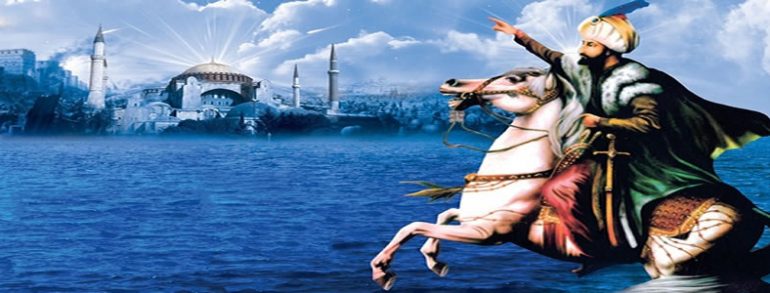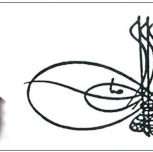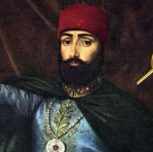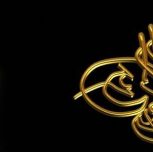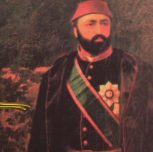(1432, 1444-1446, 1451-1481)
Dracula was afraid of only one person: Mehmed II. Dracula (or son of dragon) was the legendary vampire character of the novel, created by author Bram Stoker in 1897. In real life, Vlad Drakul (1431-1476), known as “Vlad the Impaler”, was the prince of Wallachia (today, Romania). He earned his nickname from his favorite method of torturing his tens of thousands of enemies by wood poles, and displaying them outside the city. He was defeated by Mehmed II in a war in 1462, and then was beheaded in 1476. Knowing that Mehmed was only 21 when he conquered Constantinople in 1453, Dracula had a right to be scared of him.
Born on 30 March 1432 in Edirne, then the capital of the Empire, Mehmed, the seventh Sultan of the Ottoman Empire was the fourth son of Sultan Murad II and his wife, Hümâ Hatun.
Speaking fluent Turkish, Greek, Serbian, and understanding Arabic and Persian, the well-educated Sultan was a true intellect and international leader. He was taught one-on-one by the best teachers and scholars of his time, equipping him with similar qualifications to those who have founded other empires.
His political career started at the early age of 11. He was sent to Manisa in the beginning of 1443 as Governor.
Mehmed II’s First Accession to the Throne on August 1444
Sultan Murad II (1404, 1421-1444, 1446-1451) was patriot, merciful, trustworthy, courageous and cautious. He liked literature, poetry, music, and was a very sensitive man. On the other hand, he enjoyed entertainment a great deal. The sudden death of Alâeddîn Ali Çelebi, his favorite and most trusted son, in late 1443 in Amasya deeply affected Sultan Murad II.
Even though Murad killed three of his brothers to provide an order in the empire, losing his own son was different. In front of his officers, Murad resigned in August 1444 from his chair in favor of 12-year-old Mehmed II, and went to Bursa, where he turned his focus to religion.
During the very critical period of the empire, having a 12-year-old sultan caused unrest within the elite and the public. Grand Vizier Çandarlı Halil Pasha gained great power, but this created disturbance among Mehmed’s other viziers, mostly Zağanos and Ibrahim Pashas. When the crusader’s threat became real, Çandarlı invited Murad II into the commanding post; he came and defeated the crusaders in the Battle of Varna on November 1444.
When the unrest among the people increased, Murad II saw the danger and returned to his old position on 5 May 1446 to be the Sultan a second time. Mehmed was sent to Manisa.
This five-year period before his second accession to the throne was very important in Mehmed II’s career. Not only did he improve himself, but he also built his second term based on the experience in these teenage years. He lost his mother in 1449.
Mehmed was not Murad’s favorite son; therefore, he always needed to prove himself to his father, so, he worked hard. His charisma together with his wise, courageous, inquisitive, observant, diligent and pious personality, including his failures, helped him success. Meanwhile, Zağanos openly opposed the policies of Çandarlı.
Until the reign of Murad II, the sultans among the Ottoman elites were probably primus inter pares (first among equals). The death of Murad II marked the end of the “old” Ottoman system. With Mehmed II, what we now know as the Ottoman Empire, started to form by the devşirme system.
In 1450, on the other side of the Atlantic, the Inca Empire in Peru constructed Machu Picchu, the iconic city of Inca civilization. The “lost city” was located 2430 meters above sea level on the eastern slopes of the Andes.
His Second Accession to the Throne on 18 February 1451
Upon the death of Sultan Murad II at the age of 48 on 3 February 1451 at Edirne, 19-year-old Mehmed left Manisa and went to Edirne where he acceded to the throne the second time on 18 February 1451. Mehmed did not change Çandarlı Halil Pasha, the Grand Vizier, and his ministers, but he ordered the strangling of two-year-old Ahmed, his half-brother. In the later years, he legalized this kind of killing of family members to protect the “order” of the empire by legalizing the “law of fratricide”.
After the first two-year term as a sultan, waiting for five years for his second term must have been very motivating for Mehmed. He kept his emotions and plans to himself, and educated himself very well, acquiring what he needed for the future.
With the help of the Venetians, Ibrahim Bey of Karamanoğlu, a central Anatolian chieftain, tried to take advantage of the change on the Ottoman throne, eventually declaring a truce after Mehmed moved in to challenge him. His success encouraged the Janissary army to ask for a bonus. Mehmed paid them, but punished afterwards all the high-ranking commanders to discourage them to ask again.
Mehmed had only one thing in his mind; to capture Constantinople, and had one strategy; to freeze all the other issues. Therefore, he renewed his father’s peace agreements with Venice on 15 September 1451, and conceded to the Hungarian demand on 20 November 1451 in exchange for a three-year truce. He also provided his assurances to the Byzantine Empire and Serbia. In his administration, the Grand Vizier Çandarlı Halil Pasha was still the strongest opponent of this conquest.
While Mehmed was planning his conquest, thousands of kilometers away, German Johannes Gutenberg (1395-1468) was planning his invention; the printing machine. Both men reached their goal at almost the same time. Mehmed captured Constantinople in 1453, and Gutenberg successfully printed his first Bible in 1454.
The Conquest on May 29, 1453
Genoese and Venetian commercial ships were sailing back and forth between the Aegean Sea and Black Sea through the Bosphorus. Mehmed was uncomfortable with this sea traffic, since it included the risk of bringing military support to Constantinople from the Black Sea during the siege. In order to control the sea traffic, Mehmed ordered the Rumeli Castle (Rumeli Hisarı) be built at the narrowest point of the European side of the Bosphorus, right across from the Anatolian Castle (Anadolu Hisarı) on the Anatolian side, which was built by the Ottoman Sultan Bayezid I in the early 1390s for the same purpose. Ottomans did not have a strong navy, and needed a safe passing for when the Ottoman army crosses the Bosphorus. The new castle, built within eight months in late August 1452, consists of one small tower, and thirteen small watchtowers situated on the walls connecting the three main towers (one of them was dedicated to Zağanos Pasha). He also reinforced the Anadolu Hisarı fortress.
The formidable Theodosius Walls, consisting of an inner wall, outer wall and a moat, was the strongest defensive system in the world. Somehow though the Latins of the Fourth Crusade passed it through its Sea Walls from the Golden Horn in 1204. Mehmed II targeted to enter the city through the Land Walls in the west. He needed a special cannon to penetrate the wall. Therefore, he used the 17-ton Şâhi Cannon, able to fire a cannon ball up to 700 kg. It was the most impressive artillery of all time, and the largest gun ever made. The huge canon targeted three points of a triangle on the wall. The other siege cannons targeted in the middle of that triangle until they opened a hole on the wall.
He planned to do significant damage to the wall from above the ground as well as under the ground. His plan included digging tunnels underground until reaching a point right below the wall, and bombing it from underneath in order to cause a collapse. Ottomans were specialized in tunnel technologies and even had a special division in their army, called Lağımcılar (tunnel diggers).
Mehmed compiled an army of around 60,000. It was a sizable army compared to the Byzantine army of less than 10,000, one third of whom were Latin. In addition to the professional army, called Janissaries, the Ottoman army employed Greeks, Serbians, Germans and other nationalities. According to the medieval tradition, if the city does not surrender, the capturing army was allowed to loot the city for three days. This rule encouraged men to join the army at wartime, but the three-day rule for looting was decreased to one and a half days in the case of Constantinople.
Mehmet II offered Emperor Constantine XI (1449-1453) to surrender the city, but he declined. The assault on Constantinople started on April 6, 1453. The Genovese Colony in Galata (Pera) stayed neutral. Upon Constantine XI's request for help from Genoa, three Genoese and one Latin ships came to defend Constantinople on April 20. In spite of the Ottoman navy, they were able to arrive at the shore of the Sea of Marmara and brought help to the Byzantium from the Golden Gate. The entrance of the Golden Horn was closed by a strong chain, preventing ships penetrating into the bay. Two days later, on April 22, Ottomans carried a number of boats over the Galata hill down into the Golden Horn to divert the Byzantine defenders. As Latins believed that their commercial interest in the region would be at risk, they defended the city more than the local citizens did.
Sultan Mehmet II attacked the city on and off the following 53 days. On May 29, 1453, he made the last deadly attack from the west side of the city. It is not certain where exactly the Ottomans entered the city, but it is believed that it is most likely between the Romanos Gate (Top Kapısı) and the Charisius Gate (Edirnekapı). This section was considered the weakest part of the walls. The Ottomans entirely destroyed a part of the wall and entered the city. Emperor Constantine XI bravely defended his city, and died in the last day of the siege.
After the Conquest
Mehmed II, honored with the title of the "Conqueror" ("Fatih" in Turkish), entered the city the first day, and went to the church of Hagia Sophia, where he prayed after converting it into a mosque.
He let his army loot the city just for one and a half days, instead of the traditional three days. He then strictly protected the citizens and the city. He did not want to harm the city, as he planned to make the undamaged Constantinople the capital of the Ottoman Empire. He calmed the citizens of Constantinople and told them to return to their homes safely and continue their daily routines. Most importantly, he freed all the slaves.
Mehmed II positioned himself as the absolute ruler of a centralized empire. He wrote in Greek and used the title "the Caesar of the Roman Empire" (Kayser-i Rûm) in his international correspondents, especially with Venetians, to emphasize that his empire was the continuation of the Eastern Roman Empire. He converted it into a mosque, but kept the name of Ayasofya (Hagia Sophia). Mehmed also installed Gennadius Scolarious as the Patriarch of Constantinople in order to prove his capacity as the Caesar of the Roman Empire. By doing the same thing with the Armenian and the Jewish communities, he created the millet system of autonomous self-government under religious leaders.
On 1 June 1453, Genoese surrendered Galata to Zağanos Pasha, and received the free-trade privileges within the empire. The same day, Mehmed II dismissed Çandarlı Halil Pasha, and appointed Zağanos Pasha, as the Grand Vizier. Zağanos Pasha was marked to be the first devşirme, who held the highest position in the empire. This was a part of Mehmed’s plan to utilize the devşirme system(started in 1363, and ended in 1909) more in the empire completely. In the devşirme system, the Ottomans took gifted boys from their Balkan families, and employed them in military and civil services after giving them a good education. Zaganos Pasha was a devşirme and became the second important person in the empire after the sultan. Mehmed II also increased the power of the position of grand vizier.
In order to avoid the influence of their families over the Ottomans, the following sultans after Mehmed II never married women from local or international royal families. Instead, they picked their wives from the Harem, where concubines came from the Balkans, Caucasia, Europe or Anatolia.
Thus, Mehmed II established an elite administration compiled by gifted devşirmes, and governed the people through religious leaders of the millet system (which ended after the Tanzimât in 1839). He also unified the civil code to be applied in all the conquered territories based on their historical background as well as secular and religious perspective. He combined Turkish, Iranian, Islamic, and Roman systems in one entity, the Ottoman Empire. The other system was the tımar system, in which land was granted in return for military service.
The year 1453 was also an important turning point for England and France. It marked the end of the “Hundred Years War” (1337-1453) between these two countries. Less than two months after the conquest of Constantinople, the Battle of Castillon on 17 July 1453 ended with the French victory. Secure France turned its attention to Italy, but vulnerable northern Italy together with Venice took a defensive position, and established the Italian League in January 1455, which produced a period of “balance of power” until 1494.
Mehmed employed three children of Theodore, who was the brother of the last Emperor Constantine XI (who had died during the conquest and had no children of his own). They all became high-ranking Ottoman officials. One of the children was Mesih Paşa, who worked in the Ottoman navy, and became Grand Vizier of the Ottoman Empire from 1499-1501 during the reign of Bayezid II (1481-1512). The other was Has Murad Paşa, who also became a high-ranking Ottoman official. Has Murad Paşa and Mesih Paşa were converted into Islam early on. The third child stayed as Christian.
During most of Mehmed’s term, England was busy with its own internal affairs, namely the “Wars of the Roses”, which lasted almost 30 years between 1455 and 1485 right after the loss of the Hundred Years War against France. The war between the houses of Lancaster (red rose) and York (white rose) ended with the victory of the House of Tudor (Lancaster), after Henry VII (1485-1509) defeated Richard III, the York King, in August 1485. Henry VII eventually united both Houses by marrying Elizabeth of York in January 1486. The unearthing of Richard III’s bones in 2012 from a parking lot, which had been a cemetery, in Leicester, England, became one of the most remarkable archaeological discoveries in English history.
After the fall of Constantinople, some other European countries used the Roman title of Caesar, which was inspired from the name of the legendary Roman Empire Gaius Julius Caesar (100-44 bc). Each country had their own reasons. The idea of the “Third Rome” after the fall of Constantinople (Second Rome) had gained popularity in Russia in the first half of the 16th century. In 1547, Ivan IV (1530–1584), Ivan the Terrible, was crowned as the first “Czar of all Rus" in Moscow, Russia. The idea of Third Rome was originated by the letter written by Filofei (Philotheus) of Pskov, and addressed to the Moscow grand prince Vasili III (1479–1533), saying, “For two Romes have fallen, but the third stands,”. The term “Czar” (or Tsar) was derived from the Latin word “Caesar”. The rulers of the German Empire (1871-1918) (Kaiserreich) also used the title “Kaiser”, which was derived from the word Caesar. The Ottoman rulers always used the title “Sultan” before their names (for example, Sultan Mehmed II), which was also the case with the Great Seljuks, the predecessors of the Ottomans. Daughters and wives of the Ottoman rulers used the title “sultan” following their names, (e.g. Hürrem Sultan).
Economic Developments
The young and skilled Sultan rejuvenated the economic life and reinstalled the city's "commercial center" identity. This was essential for the multi-language, multi-religion, and multi-ethnic Eurasian empire. He established specialized market places, like the Grand Bazaar, and established new social and commercial foundations together with their supporting institutions (külliyes). In Galata, he built two new plants, a shipyard in Kasımpaşa, west of Galata, and a cannon factory in Tophane, east of Galata. He restored the water system of the city.
He renovated the Theodosius Walls, rebuilt the famous Golden Gate of Constantinople in 1458, and named it Yedikule Fortress (The Castle of Seven Towers). It was originally built in 386 by Theodosius I and was included in the wall system by Theodosius II in the 5thcentury. Yedikule was built to function as a safe for the Ottoman treasury, but later was used as a high security prison for political inmates.
The same year,1458, Mehmed II ordered the building of the Eyüp Sultan Mosque (Eyüp Sultan Cami) to honor Eyüp Ensari (Ayoub al-Ansari), the standard-bearer and close friend of the Prophet Mohammed. Eyüp died during the Arab siege of Constantinople in the late 7th century. The Eyüp Mosque was surrounded by a bath (hamam), school, fountain and kitchen. Because of its religious importance, in later centuries, a vast cemetery developed around the mosque. The sword-bearing ceremonies of the following sultans were also held there.
The Fatih Mosque Complex ("Fatih" means conqueror in Turkish), the first imperial (selâtin) mosque in Istanbul, was built starting around March 1463 and completed in December 1470, on the site of the Church of the Twelve Hagia (Holy) Apostles (On İki Havâri Kilisesi), which had been looted, and destroyed by the Fourth Crusade in 1204. The church was second in size and importance to the Hagia Sophia, as it hosted bodies of twelve apostles, which were brought to Constantinople by many emperors. It was the Christian belief that relics of saints and martyrs are a more potent protection for cities than walls and towers. It is also believed that Constantine the Great was buried in that church. In later centuries, Byzantine emperors preferred to be buried there. This richly decorated church, occupied by the patriarchate, was in very poor shape during the conquest. Mehmed II, as the "Caesar of the Roman Empire", built a mosque complex, and desired to be buried in a mausoleum located on that sacred land.
Education was a priority for Mehmed II, as he was so well educated. After the conquest, he converted eight churches into medreses (middle schools), including the Zeyrek Medrese (Monastery of Christ Pantokrator). He opened the Hagia Sophia Medrese. These two medreses led the foundation of Istanbul University, currently situated in the Beyazit Square (formerly, Forum of Theodosius). The Fatih Complex (külliye) built by Mehmed II, included colleges known as the Sahn-ı Seman (Eight Auditoriums) or Semaniye Medreses. Mehmed II liked literature and wrote poems. Actually, he became the first sultan who used a pseudonym, which was “Avni”. The leading Turkish mathematician and astronomer, Ali Kuşçu (?-1474), emigrated from Samarkand (today. Uzbekistan) in 1473 to teach mathematics and astronomy in the medreses of Hagia Sophia and Semaniye.
Mehmed II did not move the capital to Istanbul right away. He governed the empire in early years from the Ottoman Palace in Edirne, 237 km west from Istanbul. The Byzantium palace was then in Blachernae (today Edirnekapi), about 5 km from the Sea of Marmara. The area of Blachernae, including the palace, was almost destroyed during the conquest. Mehmed II, instead of staying in Blachernae, built his own palace in the neighborhood of Beyazit Square, currently occupied by Istanbul University. He afterwards permanently moved the capital of the empire to his palace in Istanbul. However, due to security reasons, the palace did not serve his purpose, therefore, Mehmed II decided to build a better palace. The best possible place was the field located on the first hill by the Sea of Marmara. The area was well protected. The construction of the New Palace, Topkapı Place, was started around 1460 and completed in 1478. The Old Palace in Beyazit Square served as a royal residence until the mid-16th century.
Around 1478, the Demak Great Mosque (Masjid Agung Demak), the oldest mosque in Java, Indonesia, was built by the Wali Songo ("nine Muslim saints") during the first Demak Sultanate reign. The mosque, made of wood, has a tiered pyramid roof instead of a dome, as was the case with mosques in the Middle East. It is on the tentative list of the Unesco World Heritage monument list.
Final Years
After his wars and expenses in the city, he decreased the value of the money five times during his reign. Lowering the purchasing power caused serious social unrest. He rearranged the rules of land ownership, which created further anger among the people.
Mehmed II well managed the fight against the great plague occurring in the summer of 1467 in Istanbul. Almost six hundred people died each day, far less than otherwise could have been affected.
After his victory over Uzun Hasan of Akkoyunlu in the east on 24 August 1473, he cemented his power in the east. Two years later on 6 June 1475, Kaffa of Crimea surrendered. This gave him full control of the Black Sea. His peace agreement with the Venetians on 25 January 1479 gave him a secure territory in the Balkans in the west. Gentile Bellini (1429-1507), the prestigious Venetian painter, came to Istanbul to paint Mehmed II’s portrait in 1479. This was a good will sign between Venice and the Ottomans. Both sides reached their aims.
Mehmed II killed three grand viziers, out of eight he worked with. He did not even keep Zağanos Pasha more than two years in his position as grand vizier. He applied the same rule to his own family by legalizing the law of fratricide.
To increase the population, he forced successive waves of immigration. He also instituted brand new rules and laws necessary for the foundation of the state.
Sultan Mehmed II set out another military campaign eastwards on 3 May 1481. Shortly after he crossed the Bosphorus, he passed away at the age of 49. He was heavy and had long been suffering from gout.
Mehmed II had three sons, Bâyezid II, Şehzâde Mustafa and Cem Sultan. All of them were poisoned for different reasons. The death of Şehzâde Mustafa in January 1474 shook him and the empire. It was rumored that he had an affair with a married woman. Therefore, he was poisoned by her husband. It is whispered that the man was Mahmud Pasha, the Grand Vizier, who was killed by Mehmed II in the same year. However, historians believe that Mahmud's execution was due to his bad agreement with Uzun Hasan of Akkoyunlu.
Upon the death of Mehmed, Bâyezid and Cem Sultan started to compete with each other to be the next sultan. This time, the “war party”, represented by devşirmes and Janissaries, turned to a “peace party”. They supported Bâyezid. On the other hand, the Turkish aristocracy, who was the advocate of caution, supported the more active prince, Cem Sultan. Bâyezid came out victorious in this competition. Cem Sultan fled to Rhodes and was sheltered at the mercy of Knight Hospitallers. Cem remained a useful hostage for the rest of his life. He was eventually poisoned on 25 February 1495 by Pope Alexander VI (Rodrigo Borgia, 1431-1503).
Sultan Bâyezid II (1448, 1481-1512) faced the complaints of the public over his father’s fiscal and land policies, and had to reverse Mehmed II’s unpopular rules. His reign was a period of consolidation. He was unfortunately poisoned by his own son, Selim I, on 26 May 1512.
Sultan Mehmed II the Conqueror (Fatih Sultan Mehmet) accomplished many achievements during his reign of 32 years. Most importantly, not only did he put into place many administrative systems and conquered Constantinople, but he also brought back the prestige that the Ottomans needed then.
Alar Laats, (2011) “The Concept of the Third Rome and Its Political Implications”, p98
Ali Kuşat, (2003), “Fatih Sultan Mehmed’in Kişiliği ve Fetihteki Rolü, Psikanalitik bir Yaklaşım”, Sosyal Bilimler Enstitüsü Dergisi, Sayı.14, pp 131-148
Ayşe Kayapınar, (2013), "Bizans Tarihine Genel Bir Bakış, Bizans Tarihi", Anadolu University, Eskişehir, p 5
Boyer, Ebru and Fleet, Kate, (2010), "A Social History of Ottoman Istanbul", Cambridge University Press, p.75
Britannica, http://www.britannica.com/EBchecked/topic/509963/Wars-of-the-Roses
Britannica, http://www.britannica.com/EBchecked/topic/592484/Third-Rome
Cengiz Aydin, (1989) “Ali Kuşçu”, ISAM, Türkiye Diyanet Vakfı İslâm Araştırmaları Merkezi, Cilt.2, Istanbul, pp.408-410
Colin Heywood, (2009), “Mehmed II”, Encyclopedia of the Ottoman Empire, Encyclopedia of the Ottoman Empire, Printed in the United States of America
David B. Miller, (2006), “The Orthodox Church”, Chapter 15, From Early Rus’ to 1689, The Cambridge History of Russia, Volume 1, Cambridge University Press, p.354-355
Edhem Eldem (2009), “Istanbul, Encyclopedia of the Ottoman Empire”, Gabor Agoston and Bruce Masters, pp.287
Erhan Afyoncu (2010), http://www.bugun.com.tr/fatihin-uc-oglu-da-zehirlenmisti-yazisi-89393, 10 Ocak 2010 Pazar
Gabor Agoston, (2012), “Top, Bir Ateşli Silâh Türü”, ISAM, Türkiye Diyanet Vakfı İslâm Araştırmaları Merkezi, Cilt.41, Ankara, p.241,
Halil İnalcık, (2003), “Mehmed II, Osmanlı Padişahı”, ISAM, Türkiye Diyanet Vakfı İslâm Araştırmaları Merkezi, Cilt.28, Ankara, pp.395-407
Holger Klein, (2006), “Sacred Relics and Imperial Ceremonies at the Great Palace of Constantinople”, Visualisierungen von Herrschaft, Byzas 5 (2006) pp.79-99
İsmail Hakkı Uzunçarşılı, (1988), “Osmanlı Tarihi”, Cilt.1, p.394
Istanbul University, http://www2.istanbul.edu.tr/english/?p=68
Kate Fleet (2013), The Ottomans, 1451–1603: A political history introduction”, The Cambridge History of Turkey, Volume 2, Cambridge University Press, p.22, 27
Lowry, Heath W., (2003), "The Nature of the Early Ottoman State", SUNY Press, pp.66, 116
Mehmed Agaoglu, (1930), “The Fatih Mosque at Constantinople”, The Art Bulletin, 1930, Volume XII, pp. 179-195
Michael Mallett, (2008) “The Northern Italian States” Chapter (23a), The New Cambridge Medieval History Volume 7: c.1415–c.1500, Cambridge University Press, pp.564-569
nytimes, http://www.nytimes.com/2013/02/05/world/europe/richard-the-third-bones.html?_r=0
Rudi Paul Lindner, (2009), “Anatolia, 1300–1451, Byzantium to Turkey, 1071–1453, The Cambridge History of Turkey”, Cambridge University Press, p.137
Semavi Eyice (1995), “Fatih Camii ve Kulliyesi”, ISAM, Türkiye Diyanet Vakfı İslâm Araştırmaları Merkezi, Cilt.12, Istanbul, pp.244-249
Sergei Bogatryrev, (2006), “Ivan IV (1533–1584)”, Chapter 10, From Early Rus’ to 1689, the Cambridge History of Russia, Volume I, Cambridge University Press, p.245
Stanford Shaw, (1997), “Conquest of a New Empire: The Reign of Mehmet II, 1451-1481, the Apogee of Ottoman Power, 1451-1566”, History of the Ottoman Empire and Modern Turkey. Cambridge University Press, pp.55-70
Zeynep Tarım Ertuğ, (2012), “Topkapı Sarayı”, ISAM, Türkiye Diyanet Vakfı İslâm Araştırmaları Merkezi, Cilt.41, Istanbul, pp.256-261
Ziya Dinç, “Devşirme Sistemi”, http://www.academia.edu/3861368/Osmanli_Devsirme_Sistemi


